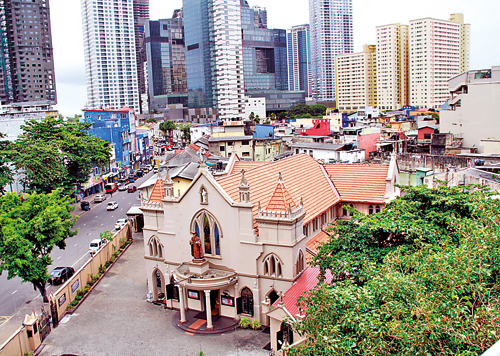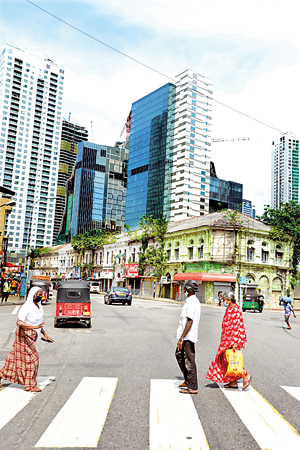Recalling a lost landscape of Kompannaveediya
“Where is the roundabout that was painted red? There used to be a green lawn on it and a prominent streetlight in the centre. People used to sit around the red concrete rise and chat into the night and during the fasting period for Ramazan many loitered at the junction into the wee hours.” I talk to my own memory now unfolding like some recovered data.

Fast changing: Old landmarks hemmed in by the high-rises. Pix by Indika Handuwala
“Thank goodness they have left the old church intact!” I sigh with some relief looking at the holy shrine of Infant Jesus occupying the triangular landmass between Justice Akbar Mawatha and Kumara Ratnam Mawatha, so named after distinguished inhabitants of the town. Most old street names such as Malay Street, Lake Road, Rifles Street, Church Street, Braybrooke Street, Staples Street, Dawson Street and Bridge Street have since been renamed.
 I am in the Slave Island thoroughfare after nearly 50 years. My memory jogs back feebly but happily to the ’60s to where I was born and raised till I left for good in 1972. There is little of that dear old landscape now as skyscrapers dominate. It was no more than a roundabout where six roads met, and the great church, the Salvation Army building, and the Nippon Hotel were the only large structures of any significance at the junction. The Manning Mansions’ Nippon served the best hot Chinese rolls and housed a flourishing barber-salon for ladies and gents. It also had a fully-fledged studio and the plush ‘Harmonics’ showrooms which sold western musical instruments.
I am in the Slave Island thoroughfare after nearly 50 years. My memory jogs back feebly but happily to the ’60s to where I was born and raised till I left for good in 1972. There is little of that dear old landscape now as skyscrapers dominate. It was no more than a roundabout where six roads met, and the great church, the Salvation Army building, and the Nippon Hotel were the only large structures of any significance at the junction. The Manning Mansions’ Nippon served the best hot Chinese rolls and housed a flourishing barber-salon for ladies and gents. It also had a fully-fledged studio and the plush ‘Harmonics’ showrooms which sold western musical instruments.
Slave Island then was multi-cultural and multi-religious. Established by the Portuguese and developed by the Dutch later adding to it the vast Beira Lake, the British brought more infrastructure with trading firms and military garrisons. Slave Island’s original settlers may have been Malays and Moors for they seem to easily outnumber the rest, but many Sinhalese and Tamils had settled there by the beginning of the 1900s. Most had migrated from the north and south of the island seeking a foothold in the city, some later becoming renowned mudalalis, fitting into the British ruled economy. Whilst the Sinhalese mudalalis prospered in the transport sector, the restaurant business that served a growing working class, running clubs for entertainment, and lending money to the needy before the banks were known, Tamil urimaiyalars opened well-stocked shops which sold multiple items wholesale and retail. They owned cinema halls (a lucrative business then). and virtually ruled the textile trade. By the time Ceylon gained independence, Slave Island had become a great trading hub.
Geographically, the Beira waterway built by the Dutch for transportation in the 17th century surrounds Slave Island. The island in the middle of the lake opposite the Colombo Commercial Company was a lush coconut grove and a family lived in a hut. They had canoes which they used for fishing. There existed a great marsh between Bishop’s College and the lake which also split the area from Alwis Town in Colpetty. Vauxhall Street ran parallel to the opposite side of the lake, and many by-lanes like Vauxhall, Kew, Bahjathul Asrar and Police extended all the way to the lakeshore from the main road.
The vast backyards of these lanes, the area behind the railway station called the ‘ganga aine waththa’ (passage next to the waterbody), and those of Wekanda were always crammed with slum-dwellers. Each area had its own hoodlum who wielded total authority and was known to demand protection money from wealthy businessmen. Such gangsters belonged to all three communities.
On the religious front, Gangaramaya known as Hunupitiye pansala then and the Gunawardanaramaya next to the Nippon hotel served the Buddhist community whilst Infant Jesus was where the Christians flocked. Hindus had the Murugan temple and the Jumma mosques of Wekanda and Kew Road were for the Moors and Malays. Occasionally, Salvation Army members – led by a brass band – paraded the streets in their uniform singing hymns. The mosques’ messenger ‘bawa’ knocked on all Islamic doors of the neighbourhood at 4 a.m., to wake the devotees for prayers during the fasting season. Dressed in ghostly white, he drummed a traditional tambourine and carried a baton to scare the stray dogs away.
Muttiah Children’s Park in front of the Gangaramaya temple, overlooking the lake had a little club house for the weightlifters and an ideal pitch in the middle for cricket. De Mel Park was where firebrand orators of the time like R. Premadasa, Haleem Ishak, Pieter Keuneman, Shanmugadasan and D.G. William of Colombo Central addressed their supporters. The City League grounds separated Slave Island from Colombo Fort and it was here the top footballers of the town practised. Every weekend saw matches featuring lanes and Java Lane probably had the best team. The annual ‘aluth avurudu uthsawaya’ was always held here and the organizers made sure to pick a handsome police officer from the barracks next door as the ‘avurudu kumaraya’!
Slave Island residents patronised the Victoria bakery next to the park for all their oven-fresh bakery products. The line of shops extending all the way from there to the railway station, was called the ‘theentha kada peliya’ (paint shops). In front of the Nippon Hotel was the Victoria wine store that also sold high quality imported food items.
The main market of Slave Island located where the Nawaloka Hospital is now, sold vegetables, fresh fish and all meats. In the same premises stood the government dispensary and a banquet hall for private functions of the community.
There were several rickshaw-stands in the vicinity of the roundabout until they were replaced by Morris Minor and Beetle meter-taxis in the early ’60s. Rickshaws and bullock carts carrying coir to the Carson Cumberbatch warehouse complex situated at the end of Vauxhall Lane were a common sight. At any given time, one could find a convoy of carts lined-up. Since most of them travelled distances at night to avoid the heat, each had a lantern dangling from either side. The Elephant House milk van delivered milk bottles with the customary green emblem in the early hours followed by the paper man. The kerosene cart, aerated-water van, the uniformed postman in a hat on his bicycle, the green pushcart selling bread and cutlets and the weekly firewood cart were regulars.
Union Place housed the offices of top commercial companies in the island and at the beginning of it, almost next to the Salvation Army building, there was Vimto House that produced the sweetest bottled drinks and had a lovely little restaurant. Further towards the Town Hall stood Fountain Café where an array of short-eats and delicious ice-creams were served by formally dressed waiters. The premises could be booked for parties and weddings as well. A mammoth banyan tree provided shelter at Union Place right opposite the café. From here, one could hop over to the Moors grounds to watch the cricket.
The Empire Theatre stood in the vicinity of the ground and was separated from it by yet another giant banyan. The Rio auditorium was built in the ’60s and one of the first films to be screened there was Cleopatra, starring Elizabeth Taylor and Richard Burton. The smaller Nawa cinema right behind the Rio catered to the Tamil speaking community with South Indian movies. But it broke all barriers in 1972 when everyone flocked to see ‘Hathi Mere Sathi’. The Hindi blockbuster with Rajesh Khanna and Tanuja ran for seven months.
Slave Island was famous for food outlets too in its day. Whilst Geetha Café and Radha Lodge offered South Indian food, there were many street-food outlets run by Malays. Amaradisi and Sinhala hotels served decent rice and curry, but Nippon was always the place for fine dining. In addition to the clubs at Union Place which served alcohol aplenty, the elderly working-class patronized the famous toddy outlet close to the station. Toddy was readily supplemented with an isso-wade cart at the entrance.
Of the well-known yesteryear mudalalis of Slave Island I remember Hinni Appuhamy who had a fleet of buses, Gajaweera who had a fleet of lorries whilst Richard owned several clubs and not forgetting Aaron who famously refused to get his name engraved on a plaque at the serene Buddha statue he built, next to the colonial railway station. All of them had hailed from the South and wore the sarong over a coat stitched by a London qualified tailor. Vishwalingam urimaiyalar, a textile magnate from the North wore their traditional verti. Sadly, they are long gone.
Came the ’70s and with the tide of commercialization, many Sinhalese and Tamil residents left the area. Over the years, new multiple-storey buildings have replaced the old slum-dwellings and Middle Eastern earnings seem to have flowed in freely. The few residential neighbourhoods are surrounded by the encroaching development and the area is visibly transforming into a business cum leisure centre -a landscaped modern township, a far cry from those sleepy streets of old Slave Island.


